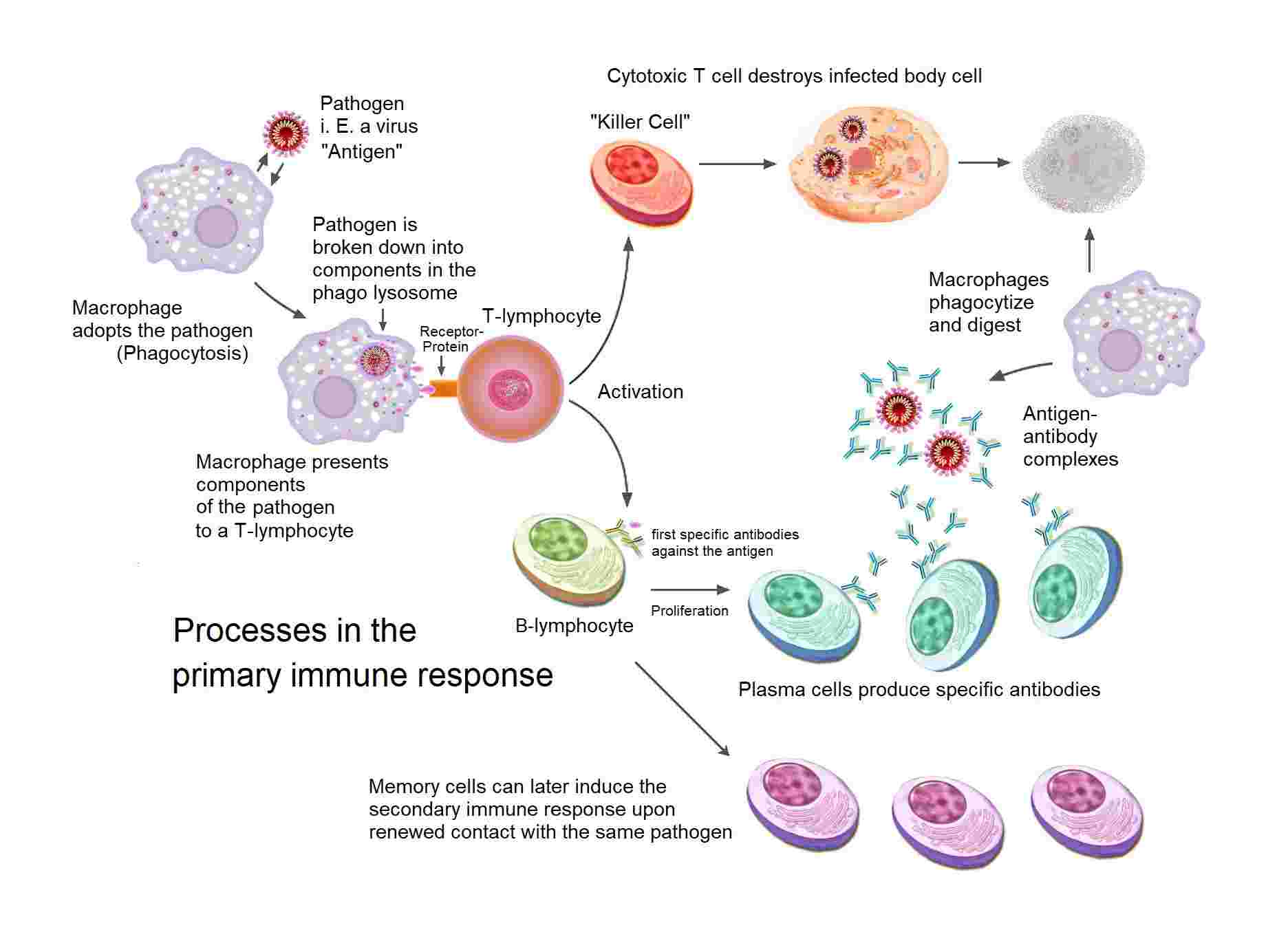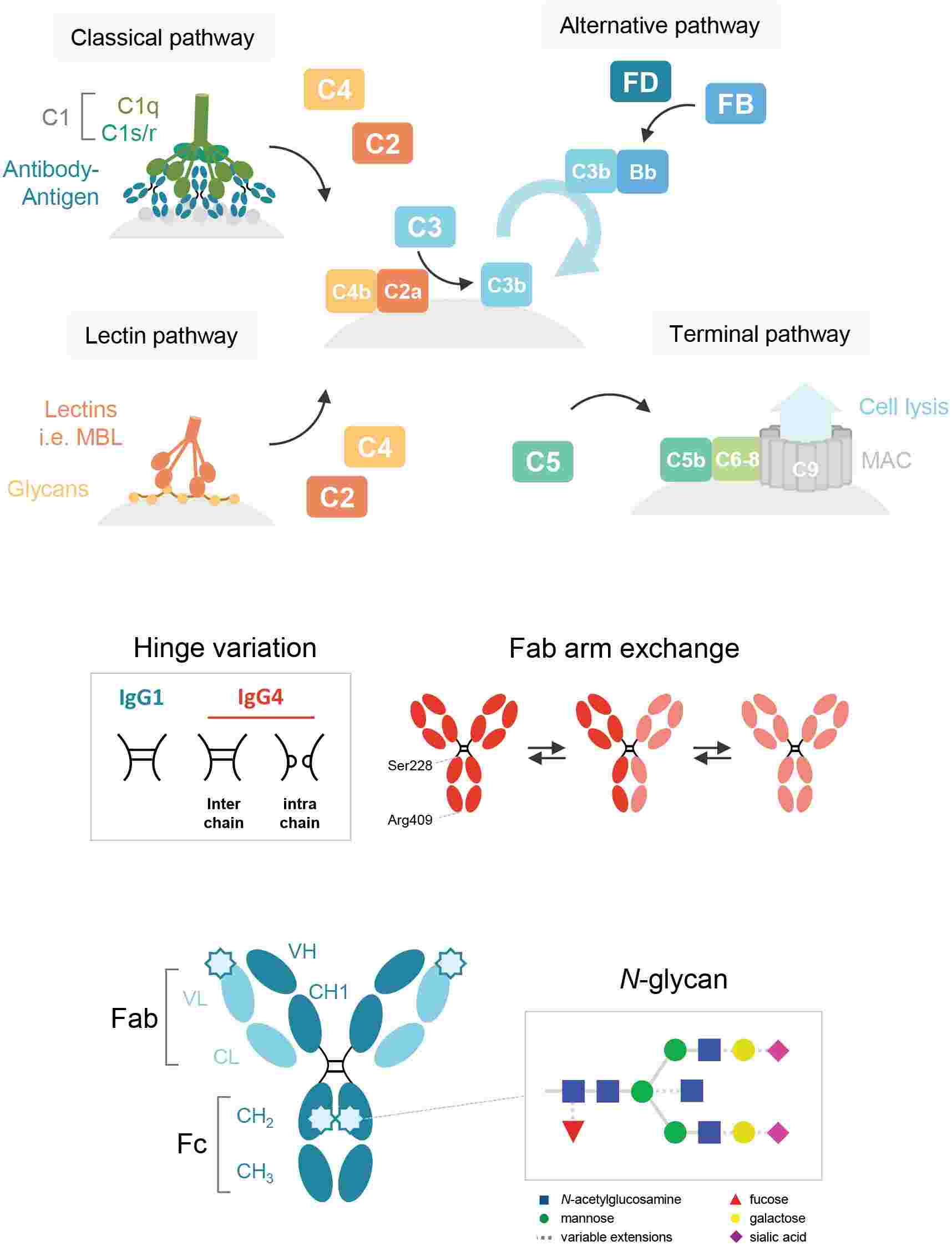Antibodies are a class of immunoglobulins (Ig) produced by B lymphocytes in response to invading foreign pathogens. These Y-shaped proteins are able to recognize and neutralize antigens with high affinity and specificity. Complement is a series of plasma proteins that can be activated directly by pathogenic agents or indirectly by pathogen-bound antibodies. They’re in the beta region analyzed by protein electrophoresis and are classified into beta globulins. The highest concentration found in complement components is C3 protein. Complement is generally inactive in serum and if becomes activated, by the following ways:
-
Antigen-antibody reactions (most often IgM), via the classical pathway;
-
virus particles, bacterial polysaccharides, enzymes, and endotoxins, via the lectin pathway and alternative pathway.
Antibody and Complement in the Immunity
An essential part of the immune system is antibody molecules. These large molecules play a key role in the defense against infectious agents (e.g. bacteria, viruses), but can also be harmful such as inducing anaphylaxis or autoimmune diseases. The consequence of recognizing a target structure relies on which effector functions the antibody can initiate, and this is in turn based on its isotype or subclass. An antibody’s effector functions are largely mediated by binding to distinct Fc-receptors or by activating the complement system.

Fig. 1 Overview of the primary immune response.1
Apart from their role in attacking pathogens, antibodies are able to regulate the immune responses against specific antigen they bind to. Instead of showing a naked antigen, immunity is presented with an immune complex composed of antigen, antibody and frequently complement components. Considering that an immune complex can interact not only with B-cell receptors but also with Fc and complement receptors, it will show many possibilities to influence dramatic immunoregulatory functions.
Complement-enhanced Antibody-mediated Neutralization
The complement system comprises dozens of proteins and protein fragments that belong to innate immunity. Most complement components are synthesized in the liver as inactive precursors and distributed by systemic blood circulation. Certain isotypes of antibodies immobilize complement via binding to CH2 domain of antibodies, in the Fc region of Ig molecules. The complement system mediates various immune functions, including aggregation of pathogens, chemotaxis-increased capacities for macrophages and neutrophils, opsonization to improve phagocytosis of virions by Fc receptor-bearing phagocytes, and lysis of cells by the assembly of a membrane attack complex (MAC). The complement fixation, that is the combining of complement with antigen-antibody complexes, is modulated by specific isotypes of antibodies and the activity normally enhances viral neutralization. Without the complement, the antibody function is weakened.
Antibodies Using Complement to Regulate Antibody Responses
Complement is known as a defense system resulting in lysis of pathogens, enhanced phagocytosis, and inflammation. Meanwhile, it also takes a critical part in the generation of antibody responses. Antibodies, forming immune complexes with their special antigens, cause complete suppression or several 100-fold improvements of antibody responses. As mentioned, the elements of immune complexes include antigens, antibodies, and, when an antibody is of a complement-activating isotype, complements. These complexes containing IgG and IgM might activate the complement and in such circumstances also complement components are part of the immune complex.

Fig. 2 Involvement of the complement system in antibody responses.2, 3
Recently, scientists review data on how antibodies upregulate specific antibody responses by the complement system. Existing data indicate that murine IgG1, IgG2a, and IgG2b improve antibody responses mostly by Fc receptors but not by complement. By contrast, IgM and IgG3 function by complement and require the expression of complement receptors 1 and 2 (CR1/CR2) present both on B cells and dendritic cells. Complement plays a significant role in antibody responses not only to antigen coupled to antibodies, but also to antigen administered alone.
Key Complement Markers for Therapeutic Antibodies
Complement acts in a continually evolving range of normal and disease-related biological processes, including immunity, development, and homeostasis. Knowledge of complement components, interactions, and cross-talk with other systems continues to grow, leading to new treatments for cancer, infections, and autoimmune diseases. Antibodies are superbly suitable for being developed into therapeutics with accurate complement stimulatory or inhibitory properties. Today, more attention is paid to the design, development, and further screening of antibody-based drugs that can promote or dampen the complement system.
Here, Creative Biolabs has built proprietary complement therapeutic platforms to develop recombinant proteins or antibodies which mimic important signaling molecules. Until now, our custom services targeting different components or markers of the complement system including but not limited to:
In particular, we also provide a series of ready-to-use antibodies that are available against various key components such as C3, C5, and C-reactive protein. These powerful antibody molecules with high sensitivity and specificity become a powerful tool to advance clients’ projects on complement system research. For more information, please directly contact us and consult our technical supports online.
References
-
From Wikipedia: Sciencia58 an the makers of the single images Domdomegg, Fæ, Petr94, Manu5 - Own Graphic using File:Macrophage.svg, File:201308 B cell.svg, File:Normal plasma blood cells.jpg, File:Aufbau einer Tierischen Zelle.jpg, File:3D medical animation coronavirus structure.jpg, source: Immune response, CC BY-SA 4.0, https://commons.wikimedia.org/wiki/File:Primary_immune_response_1.png
-
Oskam, Nienke, et al. "Factors affecting IgG4-mediated complement activation." Frontiers in Immunology 14 (2023): 1087532.
-
under Open Access license CC BY 4.0, without modification
Related Product
For Research Use Only.
Related Sections:


